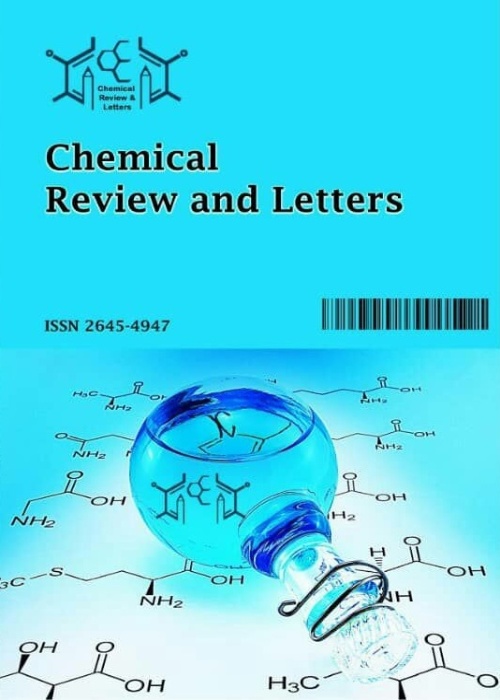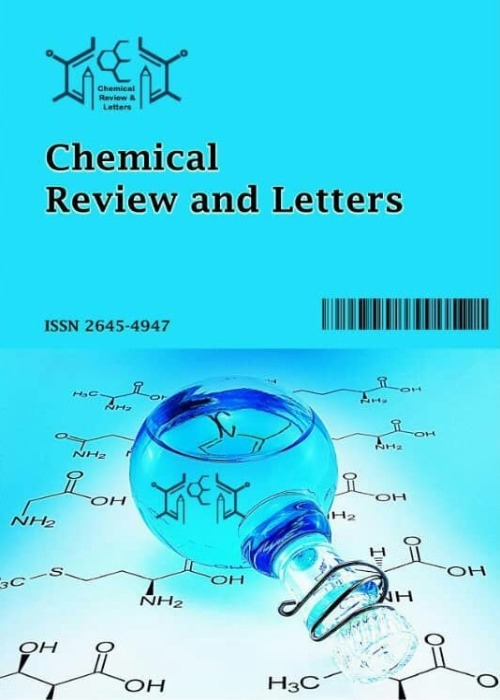فهرست مطالب

Chemical Review and Letters
Volume:5 Issue: 2, Spring 2022
- تاریخ انتشار: 1400/12/10
- تعداد عناوین: 7
-
-
Pages 106-112This study was conducted to test the impact of flush number, mushroom size and cap openness on phenolic and flavonoid contents and antioxidant properties of button mushroom (Agaricus bisporus). Results showed that all tested facrors had a significant effect on dry matter and antioxidant properties of mushroom. The first flush had the highest dry matter in comparison with second and third flushs. Antioxiant activity and flavonoid content of mushrooms in second flush was significantly more than others but for phenol content, the first flush was the best. Surprisingly, the lowest antioxidant activity, phenol, and flavonoid contents were obseved in third flush. The highest antioxidant activity, phenol, and flavonoid content were recorded in large size, medium size, and small size of mushrooms, respectively. Cap of the mushroom showed significantly more antioxidant properties and flavanoid content, however, the phenol in stipe part was more than the cap part. Closed-cap mushrooms had significantly more dry matter and total phenol content, while no significant difference was seen in antioxidant activity and flavonoid compounds. In summary, mushrooms produced in third flush have lower dietary quality than first and second flushes, cap part of button mushroom was better than stipe and total antioxidant capacity was not affected by cap opening.Keywords: Agaricus, dietary value, Antioxidant activity, Phenol, Flavonoid
-
Pages 113-118[3-(4-Methoxyphenyl)isoxazole-5-yl]-methanol was synthesized and used as an efficient inhibitor to protect copper in 1 M sulfuric acid solution. Corrosion studies were performed by electrochemical techniques, including electrochemical impedance spectroscopy (EIS) and potentiodynamic polarization (PDP), and quantum chemical calculations (Gaussian). The effect of temperature on the copper corrosion and inhibitor performance was also investigated. The data obtained from the analysis of the polarization curves disclosed that the corrosion current density (Icorr) of the metal dissolution decreased in the presence of inhibitor. This may indicate a reduction in the corrosion rate, resulting from the adsorption of inhibitor molecules on the active sites of the copper surface. Such a result was confirmed by the measured Nyquist diagrams, where total resistance increased with the addition of inhibitor to the medium. Langmuir’s adsorption isotherm was confined as best fitted isotherm describes the physical-chemical adsorption capability of the inhibitor on the copper surface. The results revealed that [3-(4-Methoxyphenyl)isoxazole-5-yl]-methanol could effectively improve the corrosion resistance of copper. The theoretical calculation of quantum chemical demonstrated the experimental findings.Keywords: copper, corrosion, Organic inhibitor, Electrochemical Impedance Spectroscopy (EIS), potentiodynamic polarization
-
Pages 119-1262,2'-((1Z,1'Z)-(((propane-1,3-diylbis(oxy))bis(2,1-phenylene))bis(methanylylidene))bis(azanyly lidene))diethanol (2-PPM) was synthesized. This compound evaluated as novel corrosion inhibitor for mild steel in 1N H2SO4 solution. Polarization study showed that the compound was mixed type inhibitor. Electrochemical impedance study showed that the presence of this compound decreases the double layer capacitance and increases the charge transfer resistance.Weight loss study showed that, the corrosion inhibition property of 2-PPM on the external area of mild steel samples in the solution is mainly depends on the inhibitor concentration and immersion period. Further, the maximum protection efficiency obtained by weight loss technique was 65 %. SEM and AFM results fully support the chemical and electrochemical results.Keywords: Corrosion, electrochemical techniques, Schiff-base, SEM, Steel
-
Pages 127-132In this paper, the precipitation of nickel-phosphorous (Ni-P) electroless coatings including Al2O3 nanoparticles (Ni-P-NA) using ultrasound waves on mild steel has been studied. Deposition process occurred in a lactic plating bath by the autocatalytic method using an ultrasound probe. The effect of radiation frequency on the properties of coatings was investigated, and the optimum frequency was determined. The obtained samples were evaluated for their corrosion resistance, surface morphology, and hardness by electrochemical impedance spectroscopy (EIS), potentiodynamic polarization, and scanning electron microscopy (SEM). The results showed that ultrasound waves caused an improvement in the corrosion resistance and uniformity of the coatings. Furthermore, five different wave frequencies applied during deposition disclosed the remarkable impact of frequency on the smoothness and corrosion resistance of the resultant coatings. On this basis, the Nyquist diagrams showed that the corrosion resistance of the prepared Ni-P-NA coating at an optimum frequency of 75 kHz was 2.59 kΩ·cm2. This value was about 2.5 times higher than the value obtained for the Ni-P-NA coating deposited without ultrasound power.Keywords: Ni-P nanocomposite coating, Sonoelectroless, corrosion, Ultrasound wave frequency
-
Pages 133-140In the last decades, wastewater from the textile industry has become a major problem which leads to increase the concentration of pollution, which in turn represents environmental risks. The presence of dyes at even very low levels in effluent is highly visible and decomposition materials of these textile dyes are often carcinogenic. Due to the complex nature of synthetic dyes, conventional biological treatment processes are ineffective. Therefore there is a need of developing treatment methods that can lead to the complete degradation of the dye molecules from waste stream. Over the last few years, advanced oxidation processes (AOPs), especially sonocatalysis and photocatalysis, have proven to be effective processes for the wastewater treatment. The current study focused to develop a catalytic reactor via immobilized TiO2 to degrade dyes in an effective method. In this research, TiO2 nanoparticles prepared via sol–gel low-temperature method was successfully immobilized within chitosan and used as heterogeneous catalyst for the degradation of Acid Orange 7 (AO7) as an anionic dye. Transmission electron microscopy, scanning electron microscopy, and X-ray diffraction analysis were employed to characterize TiO2/chitosan catalyst. Photodegradation and sonodegradation of AO7 by TiO2/chitosan catalyst has been studied. XRD analysis indicated that prepared samples were 100% anatase phase and that chitosan interacted with TiO2 nanoparticles and possessed good compatibility. TiO2/chitosan nanocomposite showed high sonocatalytic and photocatalytic activities for the degradation of AO7. The rate constant of sonocatalysis was higher than that of photocatalysis. Sonocatalytic degradation of organic dye using prepared nanocomposite could be described by the mechanisms of hot spots and sonoluminescence. Furthermore, the photocatalytic degradation of AO7 via TiO2/chitosan nanocomposite needs more time. Negative ΔG0 and ΔH0 values yielded from thermodynamic investigation proposed that the removal of AO7 via TiO2/chitosan nanocomposite was simultaneous and exothermic in nature, respectively.Keywords: Sol-gel low-temperature, TiO2, chitosan nanocomposite, Sonocatalysis, Photocatalysis
-
Pages 141-152
The research on dye solubility modeling in supercritical carbon dioxide is gaining prominence over the past few decades. A simple and ubiquitous model that is capable of accurately predicting the solubility in supercritical carbon dioxide would be invaluable for industrial and research applications. In this study, we present such a model for predicting dye solubility in supercritical carbon dioxide with ethanol as the co-solvent for a qualitatively diverse sample of eight dyes. A feed forward back propagation - artificial neural network model based on Levenberg-Marquardt algorithm was constructed with seven input parameters for solubility prediction, the network architecture was optimized to be [7-7-1] with mean absolute error, mean square error, root mean square error and Nash-Sutcliffe coefficient to be 0.026, 0.0016, 0.04 and 0.9588 respectively. Further, Pearson-product moment correlation analysis was performed to assess the relative importance of the parameters considered in the ANN model. A total of twelve prevalent semiempirical equations were also studied to analyze their efficiency in correlating to the solubility of the prepared sample. Mendez-Teja model was found to be relatively efficient with root mean square error and mean absolute error to be 0.094 and 0.0088 respectively. Furthermore, Grey relational analysis was performed and the optimum regime of temperature and pressure were identified with dye solubility as the higher the better performance characteristic. Finally, the dye specific crossover ranges were identified by analysis of isotherms and a strategy for class specific selective dye extraction using supercritical CO2 extraction process is proposed.
Keywords: Artificial neural network modeling, supercritical fluid extraction, Grey Relational Analysis, Dyestuff solubility -
Pages 153-160Water conservation is critical for both the natural environment and human development however, there is wastewater generation, particularly in the production of pulp, printing, leather, plastic, dye, and textile mills. Large-scale industrial wastewater purification necessitates the employment of low-cost adsorbents to lower the cost of large-scale industrial wastewater treatment procedures. In this study, the husk of Jatropha curcas (JHC) was carbonized, activated, and impregnate with ZnCl2 for use in batch tests to adsorb methylene blue (MB) from an aqueous solution. The effects of concentration, stirring speed, contact time, pH, and adsorbent dosage on adsorption isotherms and kinetics were examined. The Freundlich isotherm model accurately described the adsorption isotherm, while pseudo-second-order adequately fitted the kinetic data. The dye-loaded adsorbent could be regenerated by chemical regeneration after five desorption cycles. These findings suggested that JHC could be a good adsorbent for removing MB from wastewater and could help with industrial wastewater treatment.Keywords: Adsorption Isotherm, Environment, Jatropha curcas husk, Kinetics, Wastewater


